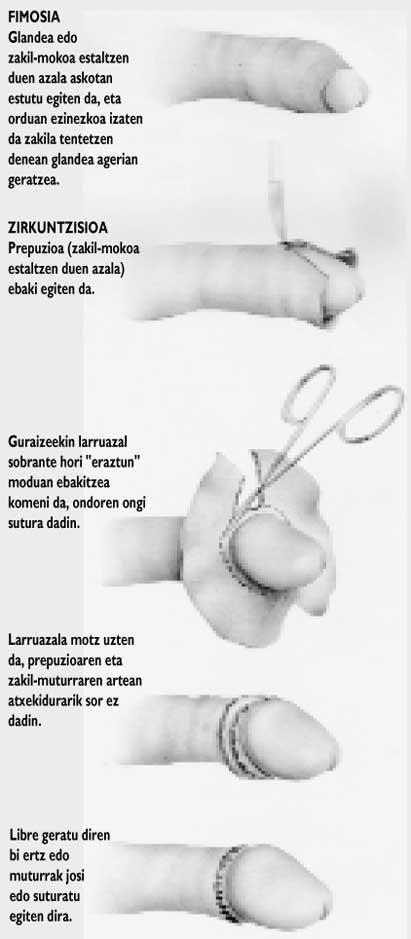Fimosis: Cut or not?
1995/03/01 Agirre, Jabier - Medikua eta OEEko kidea Iturria: Elhuyar aldizkaria
There are many reasons at stake: on the one hand, that the subject is a little “delicate” (among which are religion and morality), but on the other hand, the “morbid” that provokes in the media, with the exaggerations and myths of always.
This time I will talk about fimosis, to leave things at their point, because my daily experience has shown me that people have a lot of ignorance and confusion about this problem.
What is phimosis?
The skin that covers the glans or the peak of the penis (this is known as foreskin) is often tightened, so it is impossible that when the penis stands up it becomes manifest. This pathological situation is known as fimosis and is a common pathology in men.
Fimosis is very common, especially in young children. However, it must be said that if the prepucci retraction manoeuvre is repeated over and over again, completely removing and cleansing the penis beak, the frequency of fimosis would significantly decrease in adults.
Why does it happen? Normally it is accepted as congenital malformation, but it also appears once in men over 50 years as a result of a process of inflammation and degeneration of the foreskin: the foreskin loses its elasticity and it is impossible to completely rid the penis peak.
And how does this problem solve? Fimosis is solved with a small and simple surgical operation, with circumcision or castanage, cutting the skin surrounding the penis.
If not performed, complications (especially infectious) may appear due to lack of adequate hygiene. In some cases, the foreskin hole is so small that urine is also difficult to remove, which can cause alterations in the urinary system.
Another complication is parafimosis: the foreskin or fimotic skin is below the peak of the penis, at a given time in intercourse or masturbation. And in this situation, the foreskin creates a kind of ring, squeezing the glandé and preventing the blood from returning through reality, which causes the inflammation of the glans or the peak of the penis. Then it is necessary to bring the foreskin to its place, and the doctor will get it with manual maneuvers or a small operation.

Circumcision. Pure custom or something else?
Circumcision or ceremony. Only a simple incision, but with deep meaning. Circumcision is a ritual born thousands of years ago, in which millions and millions of people practice all over the world, mixing religion, hygiene, tradition and even rather rare concepts of morality.
There are reasons to think that circumcision also existed in the Stone Age. Throughout history it has been transformed, has undergone changes in its meaning (adopting different forms) and has been made at different times. But it remains there, as always, and it is almost impossible to despise this practice of the customs and customs of the peoples. In those peoples who had no tradition or their own history have been tamed and assimilated, and those who adopted it have also created their own history and legends.
Today, when we are going to enter the third millennium, all Jews and Muslims, as long as they are believers, go through circumcision; and many of the newborns of the United States, who according to some surveys or statistics would reach 80%, much of the American Indians (both in the North and in the Middle and South America), most of the aborigines of Micronesia and Australia. But they are not only men, but women. Around the world, it is estimated that 70 out of 100 women suffer from the excision of the clitoris, known as excision, or an even harder inferbulation, that is, circumcision and stitching of the vulva's lips.
What is the reason why people have been abuses of this type for so long? Why are traditions so hard and bloody over time maintained? The answer is simple for Jews and Muslims: it is written in the Bible, so do God and the prophet Muhammad.
In the Old Testament, in the first book of Moise s (Chapter 17, Verses 10+14), there is the order that the Jews have always fulfilled so rigorously: “All newborns will be Spanish-born eight days after their birth. It will always be like this. You will have to carry in the body the sign of the link you will open. And what among you would not have been in Spanish will not be worthy for life and will be exile from the people.”
Today no one denies the religious sense and tone, but surely, at first, teaching in Spanish would be nothing more than a rite of initiation, as it continues to be for Jewish societies and tribes.
Questions about fimosis and circumcision
What is the age most suitable for operating fimosis?
There is no special age for it, but it can be said that it is not advisable to perform the operation before a year, since it is at that age when the penis peak and the foreskin are completely separated naturally. Naturally, if any complication occurred, the surgery would take place at the same time, without any future.
In newborn children, it is often impossible for the foreskin to fully shrink, but often the doctor insists that parents do not worry. Will he not have fimosías?
You may not have it. The glans and the inner part of the foreskin are covered by a skin, which in the fetal era is united. When born, it begins to separate the skin in two layers, but the separation in most children is not yet finished, and due to the adhesion and connections between the two layers, the foreskin is barely removed completely. This is not enough to worry, since normally with the passage of time the layers are more and more separated, and according to some specialists, it can not be said that the child has fimosis before the two years.
Why don't all children fall?
It is true that Spanish has some advantages. For example, it decreases the incidence of penile cancer and the frequency of field infections. These are the reasons that are used in some countries to recommend the treatment of all newborns. However, these advantages are very relative, since the same benefits can be obtained if a proper cleaning of the prepucial zone is carried out: adequate hygiene cleans the secretions or leaks called “smegmas” that are responsible for the infections. Therefore, proper hygiene does not justify the introduction of circumcision to all newborn children.

Our baby approaches, by fimosis, to operate. We thought they would use general anesthesia, but the doctor has told us that it will not be necessary. How is it possible?
We must eliminate the pain that produces the operative act itself to perform the ceremony. This is achieved with general anesthesia or by local anesthesia of the area to intervene. When the patient is small (especially if a child), surgery with general anesthesia is usually recommended to prevent the child's nervousness from making surgery difficult.
It has been said that there are diseases of the genital apparatus almost disappeared in the Jews because all men are in Spanish. What are those diseases?
It is true that the percentage of men with penile cancer is much lower in Castilian Jews than in other social groups. And on the other hand, Jewish women with clayey processes in the cervix are also less proportionally than in the rest of social groups, and in it could be said (although not fully demonstrated) male circumcision.
On the other hand, circumcision facilitates the hygiene of the genital apparatus, which can help prevent the spread of some very rare disease, but usually Spanish-speaking men have the same risk of contracting this type of disease as any other.

Gai honi buruzko eduki gehiago
Elhuyarrek garatutako teknologia





